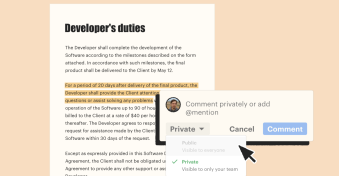This interview series aims to get the insights of our top people at PandaDoc.
Our goal is to highlight their experiences, and hear their thoughts and ideas on why they think our clients should use PandaDoc, and what separates us from our competitors.
For this piece, we have interviewed Keith Rabkin, the Chief Revenue VP at PandaDoc.
You have a lot of client-facing experience working with software companies. Can you list some common questions clients often ask when looking for a software vendor?
Truthfully, the questions I got varied depending on my role and the role of the person on the other end of the line.
However, I will say this — I’ve got my fair share of inquiries about a product’s capabilities and pricing.
For example, any client, before becoming a paying customer, always asks for cost estimates and wants to understand the complete product functionality.
Including how it can work with their existing tech stack, whether it will fit into their workflow, what type of cost-benefit it offers, what kind of integrations it has, if it is cloud-based or not, etc.
Basically, they want to know if the software they’re getting is worth every single penny or if it’s just one of those things that’ll forever be unused and make you answer Reddit threads titled “What financial decision do you still regret?”
And then some customers are the real geniuses — they throw you questions about your competitors and ask you to provide reasoning on why you’re better than them.
It’s like a high-stakes game of software poker, and you better have a winning hand.
And, as a Revenue Officer, I’ve been on the other side of the coin, too. I, too, want to buy something that has monumental value.
What do some of your customers look like in this industry, and what are their common concerns?
So, most of our clients working in the construction industry would be general contractors, small construction companies, subcontractors, home builders, enterprise construction businesses, etc.
Since PandaDoc is easily scalable, it adapts to every business type and size.
As far as their concerns go, our sales and support teams have often told us that our clients want to know about the ease of use PandaDoc offers and want to understand why it’s a better option than legacy solutions like Microsoft, which they already use.
Those are the two big questions. We also sometimes have customers asking about our product’s security, compliance, pricing, accessibility, scalability, functionality, etc.
And, then, many questions are subjective to individual businesses — for example, one question that stood out to me was, “My co-worker’s signature is illegible — will PandaDoc e-signature feature help them?”
What do you think are some of the benefits (financial or otherwise) your customers can get when switching to your solution?
I love this question!
So, if you look at cost estimates, I think the major areas you’d be saving on are manual errors and document storage costs.
You’d also see a positive increase in:
- Accuracy
- Closed deals
- And the impression of your company (in terms of costs, this one is intangible, but the impression you set in front of your customers does make a huge impact)
But I’d urge you not to stop there and instead look at the bigger picture. Think about the impact you’d be making on the environment and sustainability initiatives as a whole.
For example, in 2021, we realized the use of PandaDoc created a digital footprint that led to 12,600 trees being saved, 9.4 million lbs of greenhouse gasses being avoided, and 619,200 lbs of paper being wasted.

What are some of your popular competitors in the construction space, and what separates you from them?
Right now, we’re competing with names like Buildxact, Buildertrend, PlanSwift, and Sage.
These are all project management tools and estimating solutions, whereas PandaDoc is a document management tool — that’s to say, our product capabilities extend beyond just helping you with projects, and our aim is to instead be an all-in-one solution.
“Great tool that’s made quoting more professional and easier. It is seamless to create an e-proposal that looks professional and is easy to edit and share. Having templates and a content library has also been very useful.”
Kyanna F, PandaDoc User
That’s not the only parameter for comparison, though. Let’s compare pricing — PandaDoc pricing starts at $19/month, whereas the pricing of our competitors in this sector begins at $99/month, on the cheaper end.
Even if one were to do a one-on-one comparison, our product still significantly lands better.
For example, if you compare PandaDoc with, say Buildxact, the latter does not have templates for the construction industry, nor can it integrate with existing solutions, and it does not provide analytics on how customers interact with your documents or have 24/7 customer support, either.
Other than the above features, PandaDoc also offers:
- An e-signature tool;
- Collaboration capabilities;
- User performance and content reporting.
See how PandaDoc reporting provides insights into your team’s performance in action.
As well as your processes within workspaces allowing you to make data-informed decisions.
Click here to learn more and experience seamless customization and efficiency.
Would you agree that construction software has to offer benefits like flexibility and an easy learning curve? If yes, what has the PandaDoc team done in that regard?
Absolutely — at PandaDoc, we always advocate for ease of use! So, to make our solution easy for one and all, we offer:
- Training (we have training for individual job roles)
- Templates (you can edit ready-made professional proposals for specific tasks like bid management, creating project estimates, project management, etc.)
- 24/7 customer support (you can skip the chatbots and interact with humans to ask questions in real-time)
You can also integrate our solution with existing software tools from your tech stack to have the flexibility of working with brands you love.
For example, you can use QuickBooks to send invoices, or you can integrate with CRM tools to personalize customer interactions, or you can connect us with other estimating tools (through Zapier) to streamline business operations, get accurate estimates, and manage cost data.
Can you elaborate on how construction estimating software changes the industry as we know it?
I think, the birth of construction estimating software brought relief from working on legacy systems like Excel spreadsheets for creating cost databases.
I mean, it’s 2024 — do we really want to learn formulas for simple tasks like creating a database of change orders and adding labor costs and material costs?
Other than that, construction estimating software allows contractors to save time by managing documents, resources, and tasks efficiently.
With this software, you also get to create a centralized hub for all information, enhance your collaboration capabilities, and create a systemized process for your workflow.
A large part of your day-to-day work involves collaborating with sales teams too. If you had to give a pitch on PandaDoc to a person in the construction industry, what would it look like?
Just over the top of my head, here’s what I’m thinking:
“We know that belonging to the construction industry, paper trails are your biggest headache — after all, the databases you create for managing line items, project estimates, profit margins, etc., are not easy to manage, and truth be told, Excel is not holding up like it once used to.
So, if your construction business is scaling and you need to streamline your workflow, you can’t go wrong with PandaDoc.
It’s not only a great tool for document creation, but it’s also an excellent tool for managing all parts of your business — from preconstruction to post.
That’s to say, with PandaDoc, you can create professional proposals, manage bids, create documents, reduce manual errors, integrate with your existing systems, collaborate with stakeholders, and bid goodbye to legacy systems.”
I’m sure there’s room for some refining there (I can get my best salesperson to improve my core points here), but, like I said — it’s just the top of my head.
Disclaimer
PandaDoc is not a law firm, or a substitute for an attorney or law firm. This page is not intended to and does not provide legal advice. Should you have legal questions on the validity of e-signatures or digital signatures and the enforceability thereof, please consult with an attorney or law firm. Use of PandaDoc services are governed by our Terms of Use and Privacy Policy.


